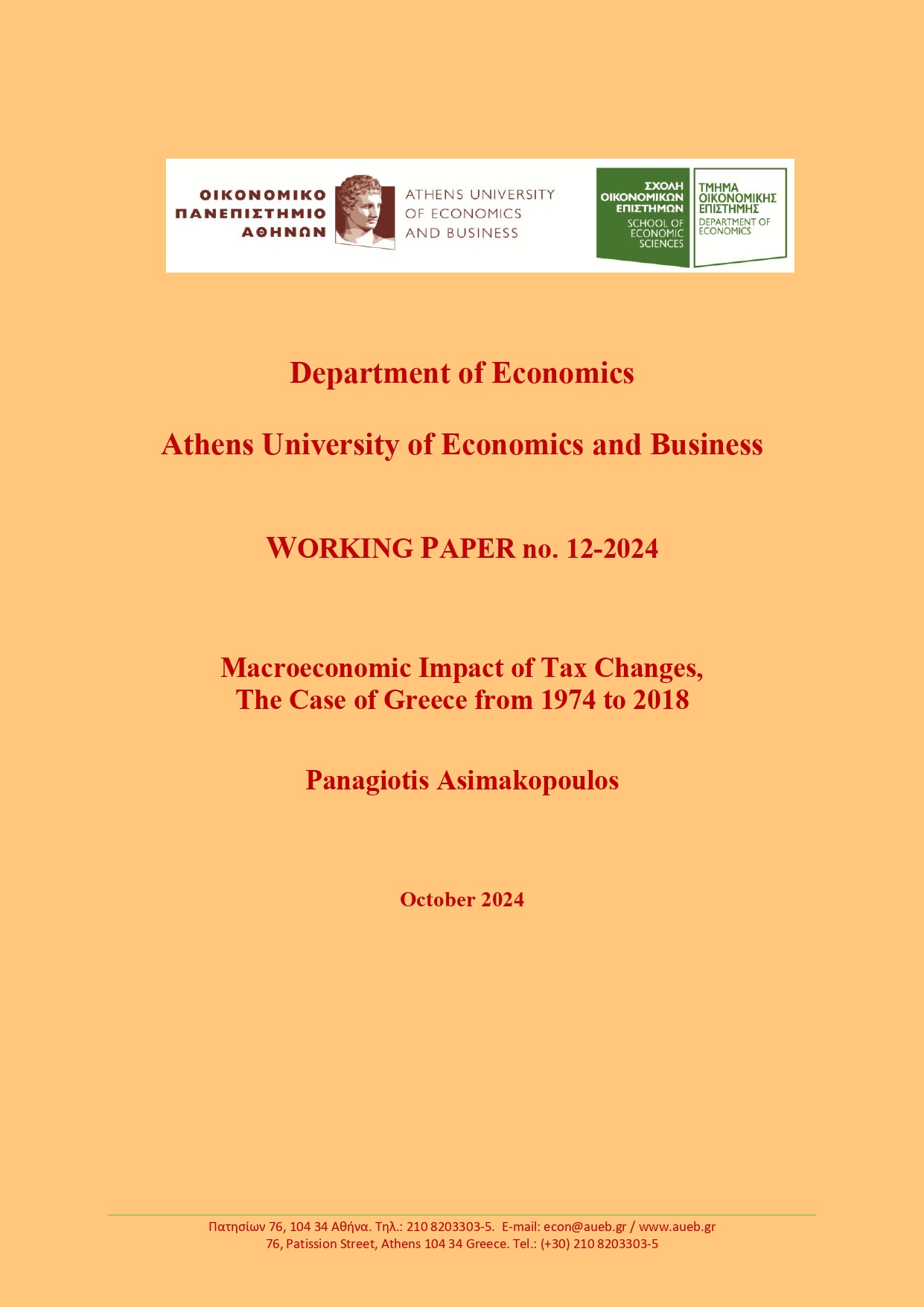Ανάρτηση Ερευνητικών Δοκιμίων no 11/24 και no 12/24
 Ερευνητικό Δοκίμιο no 11/24 με τίτλο "Evolution of Greek Tax System, A Survey of Legislated Tax Changes from 1974 to 2018"
Ερευνητικό Δοκίμιο no 11/24 με τίτλο "Evolution of Greek Tax System, A Survey of Legislated Tax Changes from 1974 to 2018"
του Παναγιώτη Ασημακόπουλου
Περίληψη
The aim of this paper is to provide a legal documentation that is conducted under a thorough review of tax legislation and create a dataset, consisting of 120 laws that brought significant changes in the vast majority of categories of taxes in Greece from 1974 to 2018. It is noteworthy that a contribution is to provide not only a legal documentation, which is carried out under a thorough review of tax legislation, but also create an exhaustive Tax Law Database consisting of Laws that brought significant changes in the tax system and more importantly covered the vast majority of categories of taxes in Greece from 1974-2018. It is crucial to highlight that our dataset, tax revenue figures, national accounts covered the period up to 2018 excluding Greece exit process from enhance fiscal surveillance, government change after election of 2019 and Covid-19 implications. It is critical to mention that except for a reliable documentation, in addition to Laws, we have also collected contemporaneous material from budgets, public finance reports, national statistics and reports from the OECD, IMF and European Commission to understand the motivation behind the exercise of tax policy changes, provide with critical insights regarding the Greek tax system and shed light on its effects. Last but not least, the legislative documentation is divided into five historically distinct parts with different political and macroeconomic backgrounds.
Ο Παναγιώτης Ασημακόπουλος είναι Υποψήφιος Διδάκτορας του τμήματος Οικονομικής Επιστήμης του Οικονομικού Πανεπιστημίου Αθηνών.
 Ερευνητικό Δοκίμιο no 12/24 με τίτλο "Macroeconomic Impact of Tax Changes, The Case of Greece from 1974 to 2018"
Ερευνητικό Δοκίμιο no 12/24 με τίτλο "Macroeconomic Impact of Tax Changes, The Case of Greece from 1974 to 2018"
του Παναγιώτη Ασημακόπουλου
Περίληψη
We adopted an empirical approach to capture the macroeconomic impact of tax changes for the examined period from 1974 to 2018. It is generally accepted that vector autoregression model (VAR) has proven useful for describing the dynamic interrelationships of multivariate series. Our empirical analysis focus on VAR models and Vector Error Correction Models to capture long term relationships Firstly, we apply a VAR (1,1) estimation that shows that the tax rate negatively affects GDP growth in the short run. The regression shows that a one percent increase in the tax rate lowers the level of GDP growth by 0,86%. Despite the fact that the results from VAR provide information on the short-run relationship between variables-in our case, it is crucial to know their long run behavior. The VAR model passes diagnostic tests such as autocorrelation, heteroskedasticity, non-normality and stability. Also, we test for cointegration and we can conclude that VAR model is useful both in short and long run and we do not need to follow error correction methods. In addition, we conducted a Granger causality test to examine the causal relationship between GDP growth and tax rates. The test suggests that GDP growth has no causal effect on tax rate while tax rate has Granger causality with GDP growth. Moreover, the system equation results of VAR model confirms that tax rate are statistically significant for the GDP growth and coefficient for the lag of GDP growth are statistically significant for the current GDP growth. Thus, we confirm the null hypothesis that tax rate and lagged GDP growth is Grange causal with GDP. Also, the impulse response analysis is used to investigate dynamic interaction between tax rates and GDP growth. We find that a one standard deviation shock in the tax rate can lead to a substantial decline in GDP growth. This negative response continues to worsen through period 2. The response remains in negative region with an upward trend through period 3. The level of GDP growth remains in steady state through periods 5 to 10. It is critical to say that the above effects are for a one-time-only change, and would fade out to zero in the long run. The effects of a permanent change are given by the cumulative impulse response function which suggest 0,0025 decline of future GDP growth to one-unit upward shift in total tax rates. Moreover, from variance decomposition analysis we conclude that GDP growth is strongly endogenous in the long run while taxation policy is strongly exogenous in long run. It is obvious from our analysis that increases in tax rates have negative effect on output and economic growth. The model 1 confirms that tax rates and tax policy in the short-run, as a policy-making tool for overall economic growth, have a Granger causality effect on GDP for the period studied from 1974 to 2018, implying that the setting and structure of taxation is important not only for fiscal consolidation issues but also for the impact on economic development. In addition, we estimate vector autoregressive model 2, VAR (1,1), and examine the short run relationship among real GDP growth, personal income taxes, tax on goods and services, property taxes, debt, general government consumption expenditure, gross fixed capital formation and household consumption. Our estimation result suggests thar personal income taxes (-1,97%), tax on goods and services (-0,85%), debt (-0,19%), general government consumption expenditure (-0,54%), and household consumption (-0,65%) are negatively correlated with GDP growth while lagged GDP growth is positively correlated with GDP growth of current period (0,48%). Also, property taxes are positively correlated with gross fixed capital formation (3,62%), while debt is positively correlated with personal income tax (0,04%) and government expenditures with tax on goods and services (0,29%). The analysis of the coefficients suggests that income taxes were the most important factor in debt servicing, which had a negative impact on growth, and taxes on goods and services (transaction taxes) served mainly to address difficulties in government spending. Increased government spending and household consumption have a negative effect on growth and investment, while property taxes are positively correlated with investment in fixed assets. Government spending is negatively correlated with gross fixed capital formation (-0.14%). The VAR model passes diagnostic tests such as autocorrelation, heteroskedasticity, and stability test. Also, we test for cointegration we can conclude that VAR model is useful in short run while we conclude that we should apply error correction methods (VECM model 1) to capture long term relationships. Moreover, we estimate vector autoregressive model 3, as VAR (1,1) and examine the short run relationship among real GDP growth, debt, general government consumption expenditure and tax rates. Our estimation result suggests that debt (-0,19%), government spending (-0,88%) and the level of taxation (-0,77%) are negatively correlated with GDP growth while lagged GDP growth is positively correlated with GDP growth of current period (0,58%). VAR model 3 passes diagnostic tests such as autocorrelation, heteroskedasticity, and non-normality and stability. Also, we test for cointegration we can conclude that VAR model is useful in short run while we conclude that we should apply error correction methods (VECM model 2) to capture long term relationships. In this context, we conclude that policymakers should pursue a strategy that promotes the rationalization of government spending and the sustainability of debt, keeping the revenue capacity at a level that does not harm long-term growth.
Ο Παναγιώτης Ασημακόπουλος είναι Υποψήφιος Διδάκτορας του τμήματος Οικονομικής Επιστήμης του Οικονομικού Πανεπιστημίου Αθηνών.





 Patision 76
Patision 76 2108203 303
2108203 303
